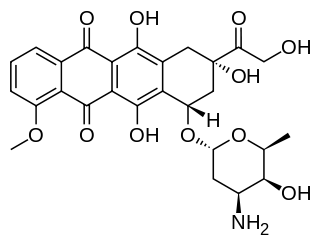
Streptomyces is the largest genus of Actinomycetota and the type genus of the family Streptomycetaceae. Over 500 species of Streptomyces bacteria have been described. As with the other Actinomycetota, streptomycetes are gram-positive, and have genomes with high GC content. Found predominantly in soil and decaying vegetation, most streptomycetes produce spores, and are noted for their distinct "earthy" odor that results from production of a volatile metabolite, geosmin.

Doxorubicin, sold under the brand name Adriamycin among others, is a chemotherapy medication used to treat cancer. This includes breast cancer, bladder cancer, Kaposi's sarcoma, lymphoma, and acute lymphocytic leukemia. It is often used together with other chemotherapy agents. Doxorubicin is given by injection into a vein.

The Streptomycetaceae are a family of Actinomycetota, making up the monotypic order Streptomycetales. It includes the important genus Streptomyces. This was the original source of many antibiotics, namely streptomycin, the first antibiotic against tuberculosis.

Tectiviridae is a family of viruses with 10 species in five genera. Bacteria serve as natural hosts. Tectiviruses have no head-tail structure, but are capable of producing tail-like tubes of ~ 60×10 nm upon adsorption or after chloroform treatment. The name is derived from Latin tectus.

In enzymology, a 3alpha(or 20beta)-hydroxysteroid dehydrogenase (EC 1.1.1.53) is an enzyme that catalyzes the chemical reaction
Streptomyces tanashiensis is a bacterium species from the genus of Streptomyces which has been isolated from soil in Japan. Streptomyces tanashiensis produces luteomycin, mithramycin, phosphoramidon and kalafungin.

Aegiceras corniculatum, commonly known as black mangrove, river mangrove, goat's horn mangrove, or khalsi, is a species of shrub or tree mangrove in the primrose family, Primulaceae, with a distribution in coastal and estuarine areas ranging from India through South East Asia to southern China, New Guinea and Australia.
Streptomyces alboflavus is a bacterium species from the genus of Streptomyces which produces oxytetracycline, tetracycline and desertomycin A.
Streptomyces cavourensis is a bacterium species from the genus of Streptomyces which has been isolated from soil in Italy. Streptomyces cavourensis produces flavensomycin.
Streptomyces cinnamoneus is a bacterium species from the genus of Streptomyces which has been isolated from soil in Japan. Streptomyces cinnamoneus produces duramycin A, duramycin B, duramycin C, carbomycin, cinnomycin and fungichromin.
Streptomyces coeruleorubidus is a bacterium species from the genus of Streptomyces which has been isolated from marine sediment. Streptomyces coeruleorubidus produces the following medications: pacidamycin 1, baumycin B1, baumycin B2, baumycin C1, feudomycin A, feudomycin B, feudomycin C, ficellomycin, feudomycinone A, and rubomycin.
Streptomyces corchorusii is a bacterium species from the genus of Streptomyces which has been isolated from soil. Streptomyces corchorusii produces butalactin.
Streptomyces flavofungini is a bacterium species from the genus of Streptomyces which has been isolated from desert sand. Streptomyces flavofungini produces flavofungin I, flavofungin II.
Streptomyces glaucescens is a bacterium species from the genus of Streptomyces which has been isolated from soil. Streptomyces glaucescens produces tetracenomycin C, tetracenomycin D and tetracenomycin E.
Streptomyces glomeratus is a bacterium species from the genus of Streptomyces. Streptomyces glomeratus produces beromycin and nogalamycin.
Streptomyces griseocarneus is a bacterium species from the genus of Streptomyces which has been isolated from soil. Streptomyces griseocarneus produces hydroxystreptomycin, alboverticillin, sphingomyelinase C and rotaventin.
Streptomyces microflavus is a bacterium species from the genus of Streptomyces which has been isolated from soil. Streptomyces microflavus produces nemadectin, fattiviracin A1, milbemycin and deoxyuridines. Streptomyces microflavus also produces the ionophore valinomycin. Streptomyces microflavus is also known to cause potato common scab disease in Korea.
Streptomyces murinus is a bacterium species from the genus of Streptomyces which has been isolated from soil. Streptomyces murinus produces the actinomycin X complex and glucose isomerase Streptomyces murinus can be used for its production of glucose isomerase in the food industry. Streptomyces murinus produces lankamycin and lankacidin.
Streptomyces rochei is a bacterium species from the genus of Streptomyces which has been isolated from soil in Russia. Streptomyces rochei produces borrelidin, butyrolactol A, butyrolactol B, uricase and streptothricin. Streptomyces rochei has antifungal activity against Fusarium oxysporum f.sp. lycopersici and Aspergillus fumigatus. Streptomyces rochei produces moenomycin and bambermycin. Streptomyces rochei produces amicetin A, amicetin B, amicetin C and streptolin. Streptomyces rochei produces endo-β-N-acetylglucosaminidase mithramycin, amicetin, bamicetin, and plicacetin.
Streptomyces xinghaiensis is a bacterium species from the genus of Streptomyces which has been isolated from marine sediments from Xinghai Bay near Dalian in China.




